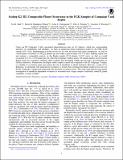Notice
This is not the latest version of this item. The latest version can be found at:https://dspace.mit.edu/handle/1721.1/132441.2
Scaling K2. III. Comparable Planet Occurrence in the FGK Samples of Campaign 5 and Kepler
| dc.contributor.author | Zink, JK | |
| dc.contributor.author | Hardegree-Ullman, KK | |
| dc.contributor.author | Christiansen, JL | |
| dc.contributor.author | Petigura, EA | |
| dc.contributor.author | Dressing, CD | |
| dc.contributor.author | Schlieder, JE | |
| dc.contributor.author | Ciardi, DR | |
| dc.contributor.author | Crossfield, IJM | |
| dc.date.accessioned | 2021-09-20T18:22:24Z | |
| dc.date.available | 2021-09-20T18:22:24Z | |
| dc.identifier.uri | https://hdl.handle.net/1721.1/132441 | |
| dc.description.abstract | © 2020. The American Astronomical Society. All rights reserved.. Using our K2 Campaign 5 fully automated planet-detection data set (43 planets), which has corresponding measures of completeness and reliability, we infer an underlying planet population model for the FGK dwarf sample (9257 stars). Implementing a broken power law for both the period and radius distributions, we find an overall planet occurrence of planets per star within a period range of 0.5-38 days. Making similar cuts and running a comparable analysis on the Kepler sample (2318 planets; 94,222 stars), we find an overall occurrence of 1.10 0.05 planets per star. Since the Campaign 5 field is nearly 120 angular degrees away from the Kepler field, this occurrence similarity offers evidence that the Kepler sample may provide a good baseline for Galactic inferences. Furthermore, the Kepler stellar sample is metal-rich compared to the K2 Campaign 5 sample, so a finding of occurrence parity may reduce the role of metallicity in planet formation. However, a weak (1.5σ) difference, in agreement with metal-driven formation, is found when assuming the Kepler model power laws for the K2 Campaign 5 sample and optimizing only the planet occurrence factor. This weak trend indicates that further investigation of metallicity-dependent occurrence is warranted once a larger sample of uniformly vetted K2 planet candidates is made available. | en_US |
| dc.language.iso | en | |
| dc.publisher | American Astronomical Society | en_US |
| dc.relation.isversionof | 10.3847/1538-3881/aba123 | en_US |
| dc.rights | Article is made available in accordance with the publisher's policy and may be subject to US copyright law. Please refer to the publisher's site for terms of use. | en_US |
| dc.source | The American Astronomical Society | en_US |
| dc.title | Scaling K2. III. Comparable Planet Occurrence in the FGK Samples of Campaign 5 and Kepler | en_US |
| dc.type | Article | en_US |
| dc.relation.journal | Astronomical Journal | en_US |
| dc.eprint.version | Final published version | en_US |
| dc.type.uri | http://purl.org/eprint/type/JournalArticle | en_US |
| eprint.status | http://purl.org/eprint/status/PeerReviewed | en_US |
| dc.date.updated | 2020-10-20T14:18:56Z | |
| dspace.orderedauthors | Zink, JK; Hardegree-Ullman, KK; Christiansen, JL; Petigura, EA; Dressing, CD; Schlieder, JE; Ciardi, DR; Crossfield, IJM | en_US |
| dspace.date.submission | 2020-10-20T14:19:02Z | |
| mit.journal.volume | 160 | en_US |
| mit.journal.issue | 2 | en_US |
| mit.license | PUBLISHER_POLICY | |
| mit.metadata.status | Authority Work and Publication Information Needed |
